- Become A Member
- Gift Membership
- Kids Membership
- Other Ways to Give
- Explore Worlds
- Defend Earth

How We Work
- Education & Public Outreach
- Space Policy & Advocacy
- Science & Technology
- Global Collaboration
Our Results
Learn how our members and community are changing the worlds.
Our citizen-funded spacecraft successfully demonstrated solar sailing for CubeSats.
Space Topics
- Planets & Other Worlds
- Space Missions
- Space Policy
- Planetary Radio
- Space Images
The Planetary Report
The eclipse issue.
Science and splendor under the shadow.
Get Involved
Membership programs for explorers of all ages.
Get updates and weekly tools to learn, share, and advocate for space exploration.
Volunteer as a space advocate.
Support Our Mission
- Renew Membership
- Society Projects
The Planetary Fund
Accelerate progress in our three core enterprises — Explore Worlds, Find Life, and Defend Earth. You can support the entire fund, or designate a core enterprise of your choice.
- Strategic Framework
- News & Press
The Planetary Society
Know the cosmos and our place within it.
Our Mission
Empowering the world's citizens to advance space science and exploration.
- Explore Space
- Take Action
- Member Community
- Account Center
- “Exploration is in our nature.” - Carl Sagan
The Voyager missions
Highlights Voyager 1 and Voyager 2 launched in 1977 and made a grand tour of the solar system's outer planets. They are the only functioning spacecraft in interstellar space, and they are still sending back measurements of the interstellar medium. Each spacecraft carries a copy of the golden record, a missive from Earth to any alien lifeforms that may find the probes in the future.
What are the Voyager missions?
The Voyager program consists of two spacecraft: Voyager 1 and Voyager 2. Voyager 2 was actually launched first, in August 1977, but Voyager 1 was sent on a faster trajectory when it launched about two weeks later. They are the only two functioning spacecraft currently in interstellar space, beyond the environment controlled by the sun.
Voyager 2’s path took it past Jupiter in 1979, Saturn in 1981, Uranus in 1985, and Neptune in 1989. It is the only spacecraft to have visited Uranus or Neptune, and has provided much of the information that we use to characterize them now.
Because of its higher speed and more direct trajectory, Voyager 1 overtook Voyager 2 just a few months after they launched. It visited Jupiter in 1979 and Saturn in 1980. It overtook Pioneer 10 — the only other spacecraft in interstellar space thus far — in 1998 and is now the most distant artificial object from Earth.
How the Voyagers work
The two spacecraft are identical, each with a radio dish 3.7 meters (12 feet) across to transmit data back to Earth and a set of 16 thrusters to control their orientations and point their dishes toward Earth. The thrusters run on hydrazine fuel, but the electronic components of each spacecraft are powered by thermoelectric generators that run on plutonium. Each carries 11 scientific instruments, about half of which were designed just for observing planets and have now been shut off. The instruments that are now off include several cameras and spectrometers to examine the planets, as well as two radio-based experiments. Voyager 2 now has five functioning instruments: a magnetometer, a spectrometer designed to investigate plasmas, an instrument to measure low-energy charged particles and one for cosmic rays, and one that measures plasma waves. Voyager 1 only has four of those, as its plasma spectrometer is broken.
Jupiter findings
Over the course of their grand tours of the solar system, the Voyagers took tens of thousands of images and measurements that significantly changed our understanding of the outer planets.
At Jupiter, they gave us our first detailed ideas of how the planet’s atmosphere moves and evolves, showing that the Great Red Spot was a counter-clockwise rotating storm that interacted with other, smaller storms. They were also the first missions to spot a faint, dusty ring around Jupiter. Finally, they observed some of Jupiter’s moons, discovering Io’s volcanism, finding the linear features on Europa that were among the first hints that it might have an ocean beneath its surface, and granting Ganymede the title of largest moon in the solar system, a superlative that was previously thought to belong to Saturn’s moon Titan.
Saturn findings
Next, each spacecraft flew past Saturn, where they measured the composition and structure of Saturn’s atmosphere , and Voyager 1 also peered into Titan’s thick haze. Its observations led to the idea that Titan might have liquid hydrocarbons on its surface, a hypothesis that has since been verified by other missions. When the two missions observed Saturn’s rings, they found the gaps and waves that are well-known today. Voyager 1 also spotted three previously-unknown moons orbiting Saturn: Atlas, Prometheus, and Pandora.
Uranus and Neptune findings
After this, Voyager 1 headed out of the solar system, while Voyager 2 headed toward Uranus . There, it found 11 previously-unknown moons and two previously-unknown rings. Many of the phenomena it observed on Uranus remained unexplained, such as its unusual magnetic field and an unexpected lack of major temperature changes at different latitudes.
Voyager 2’s final stop, 12 years after it left Earth, was Neptune. When it arrived , it continued its streak of finding new moons with another haul of 6 small satellites, as well as finding rings around Neptune. As it did at Uranus, it observed the planet’s composition and magnetic field. It also found volcanic vents on Neptune’s huge moon Triton before it joined Voyager 1 on the way to interstellar space.
Interstellar space
Interstellar space begins at the heliopause, where the solar wind – a flow of charged particles released by the sun – is too weak to continue pushing against the interstellar medium, and the pressure from the two balances out. Voyager 1 officially entered interstellar space in August 2012, and Voyager 2 joined it in November 2018.
These exits were instrumental in enabling astronomers to determine where exactly the edge of interstellar space is, something that’s difficult to measure from within the solar system. They showed that interstellar space begins just over 18 billion kilometers (about 11 billion miles) from the sun. The spacecraft continue to send back data on the structure of the interstellar medium.
After its planetary encounters, Voyager 1 took the iconic “Pale Blue Dot” image , showing Earth from about 6 billion kilometers (3.7 billion miles) away. As of 2021 , Voyager 1 is about 155 astronomical units (14.4 billion miles) from Earth, and Voyager 2 is nearly 129 astronomical units (12 billion miles) away.
The golden records
Each Voyager spacecraft has a golden phonograph record affixed to its side, intended as time capsules from Earth to any extraterrestrial life that might find the probes sometime in the distant future. They are inscribed with a message from Jimmy Carter, the U.S. President at the time of launch, which reads: “This is a present from a small, distant world, a token of our sounds, our science, our images, our music, our thoughts and our feelings. We are attempting to survive our time so we may live into yours.”
The covers of the records have several images inscribed, including visual instructions on how to play them, a map of our solar system’s location with respect to a set of 14 pulsars, and a drawing of a hydrogen atom. They are plated with uranium – its rate of decay will allow any future discoverers of either of the records to calculate when they were created.
The records’ contents were selected by a committee chaired by Carl Sagan. Each contains 115 images, including scientific diagrams of the solar system and its planets, the flora and fauna of Earth, and examples of human culture. There are natural sounds, including breaking surf and birdsong, spoken greetings in 55 languages, an hour of brainwave recordings, and an eclectic selection of music ranging from Beethoven to Chuck Berry to a variety of folk music.
Learn more Voyager Mission Status Bulletin Archives Experience A Message From Earth - Inspired by the Voyager Golden Record Neptune, planet of wind and ice
Support missions like Voyager 1 and 2
Whether it's advocating, teaching, inspiring, or learning, you can do something for space, right now. Let's get to work.
For full functionality of this site it is necessary to enable JavaScript. Here are instructions on how to enable JavaScript in your web browser .

The remarkable twin Voyager spacecraft continue to explore the outer reaches of the solar system decades after they completed their surveys of the Outer Planets. Launched in 1977 (September 5 for Voyager 1 (V1) and August 20 for Voyager 2 (V2), whose trajectory took it past Jupiter after Voyager 1), the spacecraft pair made many fundamental discoveries as they flew past Jupiter (March 1979 for V1, July 1979 for V2) and Saturn (November 1980 for V1, August 1981 for V2). The path of Voyager 2 past Saturn was targeted so that it continued within the plane of the solar system, allowing it to become the first spacecraft to visit Uranus (January 1986) and Neptune (August 1989). Following the Neptune encounter, both spacecraft started a new phase of exploration under the intriguing title of the Voyager Interstellar Mission.
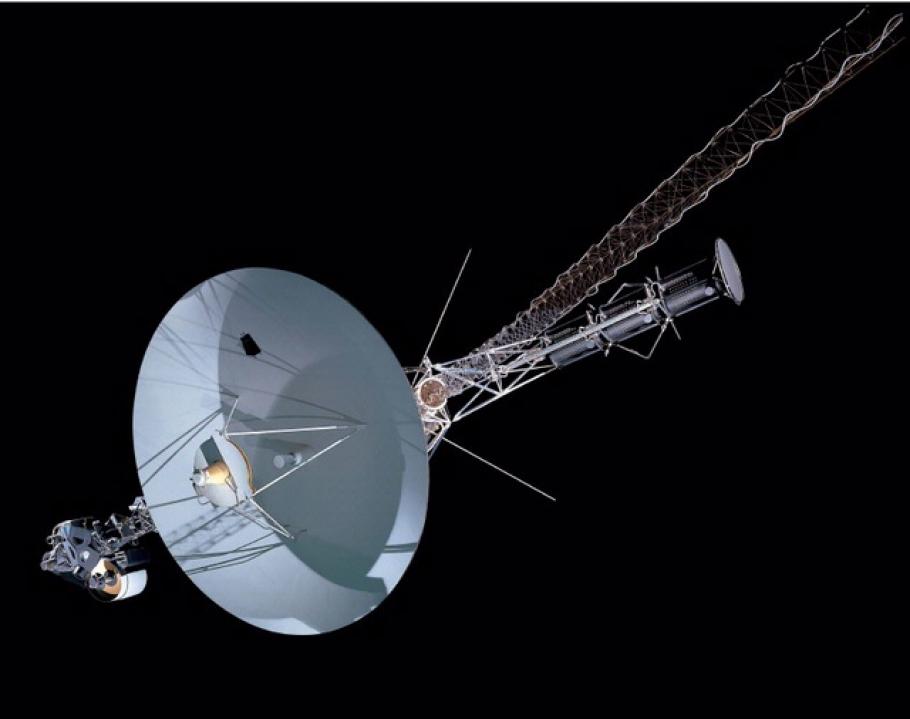
Five instruments continue to collect important measurements of magnetic fields, plasmas, and charged particles as both spacecraft explore different portions of the solar system beyond the orbits of the planets. Voyager 1 is now more than 118 astronomical units (one AU is equal to the average orbital distance of Earth from the Sun) distant from the sun, traveling at a speed (relative to the sun) of 17.1 kilometers per second (10.6 miles per second). Voyager 2 is now more than 96 AU from the sun, traveling at a speed of 15.5 kilometers per second (9.6 miles per second). Both spacecraft are moving considerably faster than Pioneers 10 and 11, two earlier spacecraft that became the first robotic visitors to fly past Jupiter and Saturn in the mid-70s.
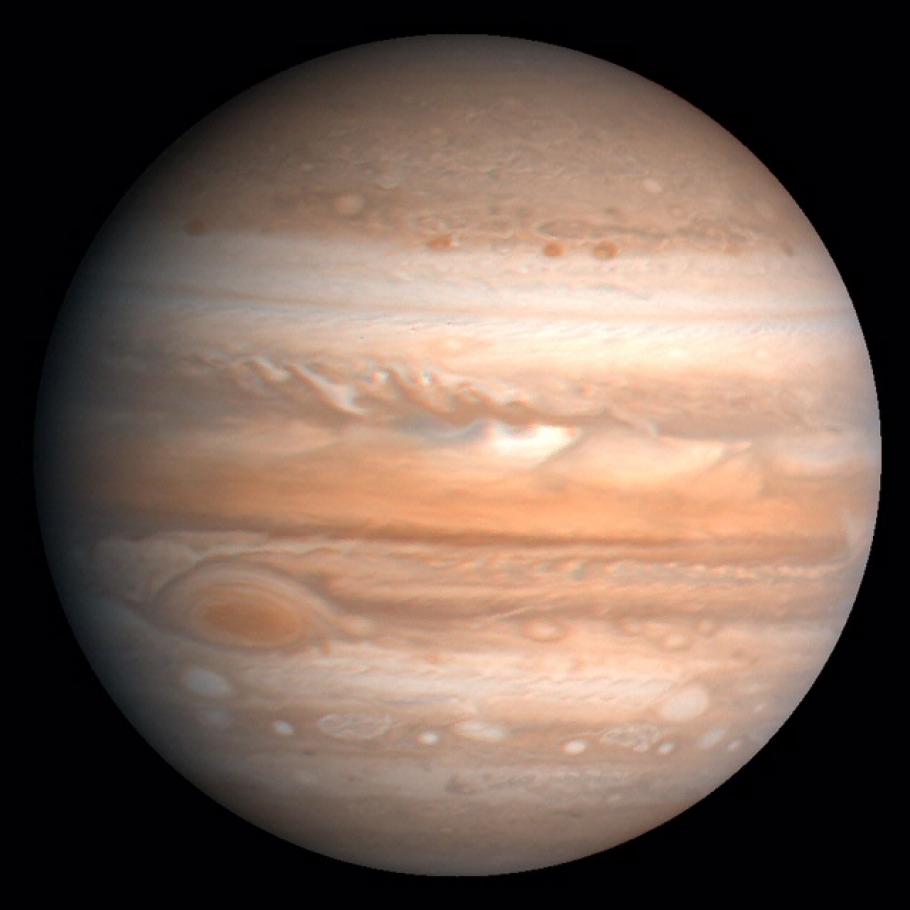
This processed color image of Jupiter was produced in 1990 by the U.S. Geological Survey from a Voyager image captured in 1979. The colors have been enhanced to bring out detail. Zones of light-colored, ascending clouds alternate with bands of dark, descending clouds. The clouds travel around the planet in alternating eastward and westward belts at speeds of up to 540 kilometers per hour. Tremendous storms as big as Earthly continents surge around the planet. The Great Red Spot (oval shape toward the lower-left) is an enormous anticyclonic storm that drifts along its belt, eventually circling the entire planet.
As seen in the night sky at Earth, Voyager 1 is within the confines of the constellation Ophiuchus, only slightly above the celestial equator; no telescope can see it, but radio contact is expected to be maintained for at least the next ten years. Voyager 2 is within the bounds of the constellation Telescopium (which somehow sounds quite appropriate) in the far southern night sky.
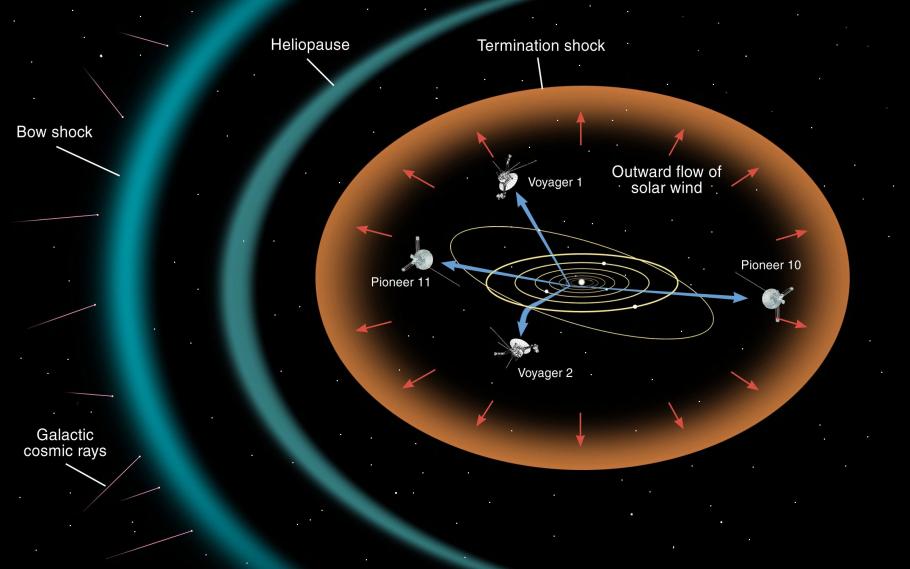
Both spacecraft have already passed something called the Termination Shock † (December 2004 for V1, August 2007 for V2), where the solar wind slows as it starts to interact with the particles and fields present between the stars. It is expected that both spacecraft will encounter the Heliopause, where the solar wind ceases as true interstellar space begins, from 10 to 20 years after crossing the Termination Shock. Theories exist for what should be present in interstellar space, but the Voyagers will become the first man-made objects to go beyond the influences of the Sun, hopefully returning the first measurements of what it is like out there. Each spacecraft is carrying a metal record with encoded sounds and sights from Earth, along with the needle needed to read the recordings, and simplified instructions for where the spacecraft came from, in case they are eventually discovered by intelligent extra-terrestrials.
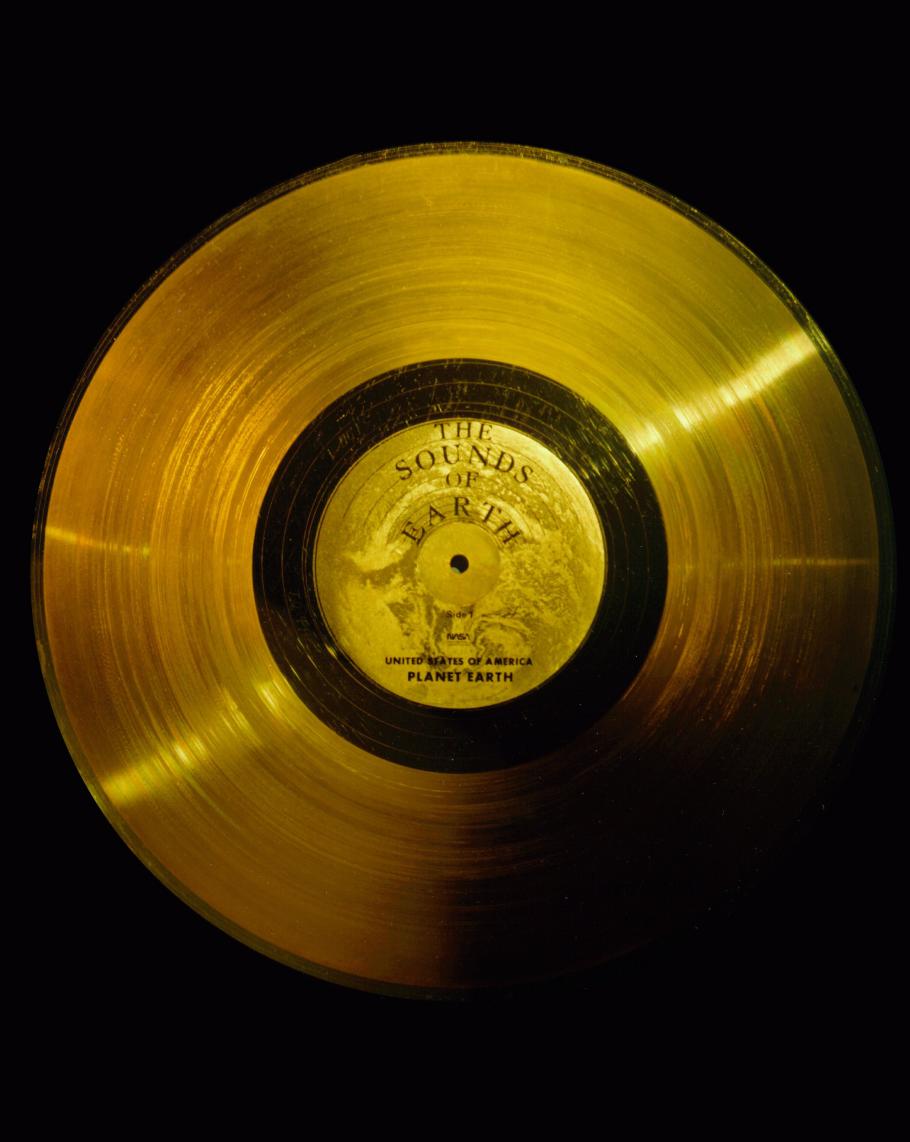
Keep track of the Voyager spacecraft on the official Voyager Interstellar Mission website or follow @NASAVoyager2 on Twitter. † The sun ejects a continuous stream of charged particles (electrons, protons, etc) that is collectively termed the solar wind. The particles are traveling extremely fast and are dense enough to form a very tenuous atmosphere; the heliosphere represents the volume of space where the effects of the solar wind dominate over those of particles in interstellar space. The solar wind particles are moving very much faster than the local speed of sound represented by their low volume density. When the particles begin to interact with interstellar particles and fields (the interaction can be either physically running into other particles or experiencing an electromagnetic force resulting from a charged particle moving within a magnetic field), then they start to slow down. The point at which they become subsonic (rather than their normal hypersonic speed) is the Termination Shock.
We rely on the generous support of donors, sponsors, members, and other benefactors to share the history and impact of aviation and spaceflight, educate the public, and inspire future generations. With your help, we can continue to preserve and safeguard the world’s most comprehensive collection of artifacts representing the great achievements of flight and space exploration.
- Get Involved
- Host an Event
Thank you. You have successfully signed up for our newsletter.
Error message, sorry, there was a problem. please ensure your details are valid and try again..
- Free Timed-Entry Passes Required
- Terms of Use

The cover of the Voyager Golden Record. The starburst pattern seen in the lower left is the pulsar map to Earth.
- NO PLACE LIKE HOME
How a NASA Spacecraft May Help Aliens Find Earth
The pulsar maps on the Voyager probes pinpoint our location in the galaxy—even as some experts debate the pros and cons of signaling ET.
Forty years ago, we sent a map to Earth sailing deep into the cosmos.
Copies of this map are etched into each of the twin Voyager spacecraft, which launched in the late 1970s and are now the farthest spacecraft from home. One of the probes has already slipped into interstellar space, and the other is skirting the fringes of our sun’s immediate neighborhood.
If it’s ever intercepted and decoded by extraterrestrials, the map will not only reveal where to find our watery little world, but also when the space probe that delivered it to alien hands left home.
“We needed to put something on the Voyager that said where it came from, and how long it was traveling,” says my dad, Frank Drake , who designed the map.
The Voyager version of route-finding pins the sun onto our galaxy using 14 pulsars, which are the rapidly spinning corpses of exploded stars. It’s a cipher unlike anything made before, the kind of object that drives entire fictional quests —and that is currently spurring arguments over the intelligence of broadcasting our existence to civilizations with possibly nefarious proclivities.
“Back when Drake did the pulsar map, and Carl Sagan and the whole team did the Voyager record, there hadn't been very much debate over the pros and cons of contact with extraterrestrial intelligence,” says York University’s Kathryn Denning , an anthropologist who studies the ethics of sending messages to extraterrestrials.
FREE BONUS ISSUE
“Now, however, as you know, there is a major debate among scientists and a variety of stakeholders about the wisdom of doing anything other than listening.”
Stellar Map Making
Drake’s cosmic directions to Earth are stamped onto the cover of the Voyager Golden Record , two of which have been ferrying the sights and sounds of planet Earth across the interstellar sea since 1977. (Find out why the Voyager mission beyond Neptune almost didn’t happen .)
But unlike the record, which grew into its final form during one short summer, the map took shape years earlier, in 1971.
Back then, my dad and Carl Sagan were designing a message to put on the Pioneer 10 and 11 spacecraft , which would be flung from the solar system after an encounter with Jupiter. One of the components he and Sagan wanted to include was a map that pointed to Earth in both space and time.
The question was, how do you create such a map in units that an extraterrestrial might understand?
Earth-years would be perfectly meaningless, because they are derived from our planet’s particular path around the sun. And there’s also the question of coordinates--in space, no one can find you using up, down, east, or west.
Even the stars themselves are constantly shifting on astronomical time scales. “Second star to the right and straight on ‘til morning” doesn’t quite work if the map is found a billion years from now and the star in question—say, Betelgeuse—has long since exploded and died.
The Magic About Pulsars
To my dad, the answer was obvious: pulsars. Discovered in 1967 by Jocelyn Bell Burnell , these dense husks of expired stars were perfect blazes in both space and time.
For starters, pulsars are incredibly long-lived, staying active for tens of millions to multiple billions of years.
Also, each pulsar is unique. They spin almost unbelievably fast, and they emit pulses of electromagnetic radiation like lighthouses. By timing those pulses, astronomers can determine a pulsar’s spin rate to a ridiculous degree of accuracy, and no two are alike.
But pulsars do slow down, sometimes by a mere but measurable billionths of a second a year. By calculating the difference between a pulsar’s spin rate when the map is found versus the spin period inscribed on the map, an intelligent being could figure out how long it had been since the map was made.
“There was a magic about pulsars … no other things in the sky had such labels on them,” Drake says. “Each one had its own distinct pulsing frequency, so it could be identified by anybody, including other creatures after a long period of time and far, far away.”

Voyager 2 launched on August 20, 1977, as seen here in a picture taken at Cape Canaveral in Florida. About two weeks later, NASA launched Voyager 1.
He reasoned that if those beings had figured out what pulsars were, they surely knew where the whirling, dead stars resided in the galaxy. Using the map, they could then follow the trail back to the sun.
You May Also Like

NASA sent a map to space to help aliens find Earth. Now it needs an update.

Life probably exists beyond Earth. So how do we find it?

Astronomers identify the stars where any aliens would have a view of Earth
After a roughly three-minute discussion with Sagan, the decision was made.
Drake drew the map using 14 known pulsars (today, that original pencil-drawn pulsar map is casually tucked into an old produce box at home ). The length of the lines connecting each pulsar to a central point—the sun—indicates how far they are from home. Along those distance markers, he inscribed the pulsars’ spin rates out to 12 digits in binary code, so any curious aliens would know which pulsars he’d chosen as anchors.
Successfully decoding the map would unambiguously pinpoint the sun’s position and the timeframe of the spacecraft’s launch.
Today, that makes some scientists and philosophers very nervous.
Dangerous Beacon?
When the Voyager spacecraft launched, astronomers had no evidence that other planets even existed outside our solar system, much less worlds capable of hosting alien life.
Now, thanks to missions like NASA’s planet-hunting Kepler endeavor, we know that planets are common in the galaxy , and that a sizable percentage of those worlds could be like Earth. The revelation has spawned efforts to send directed radio messages toward promising stars sytems.
In the wake of these discoveries, a debate has emerged over the ethics of intentionally announcing our presence to the stars . Some think the endeavour is foolish and dangerous, given how little we know about what might be out there. Others would rather prioritize listening to the stars over talking to them.
For the Voyager spacecraft, the truth is already out there, as the maps they carry hurtle deeper into the void.
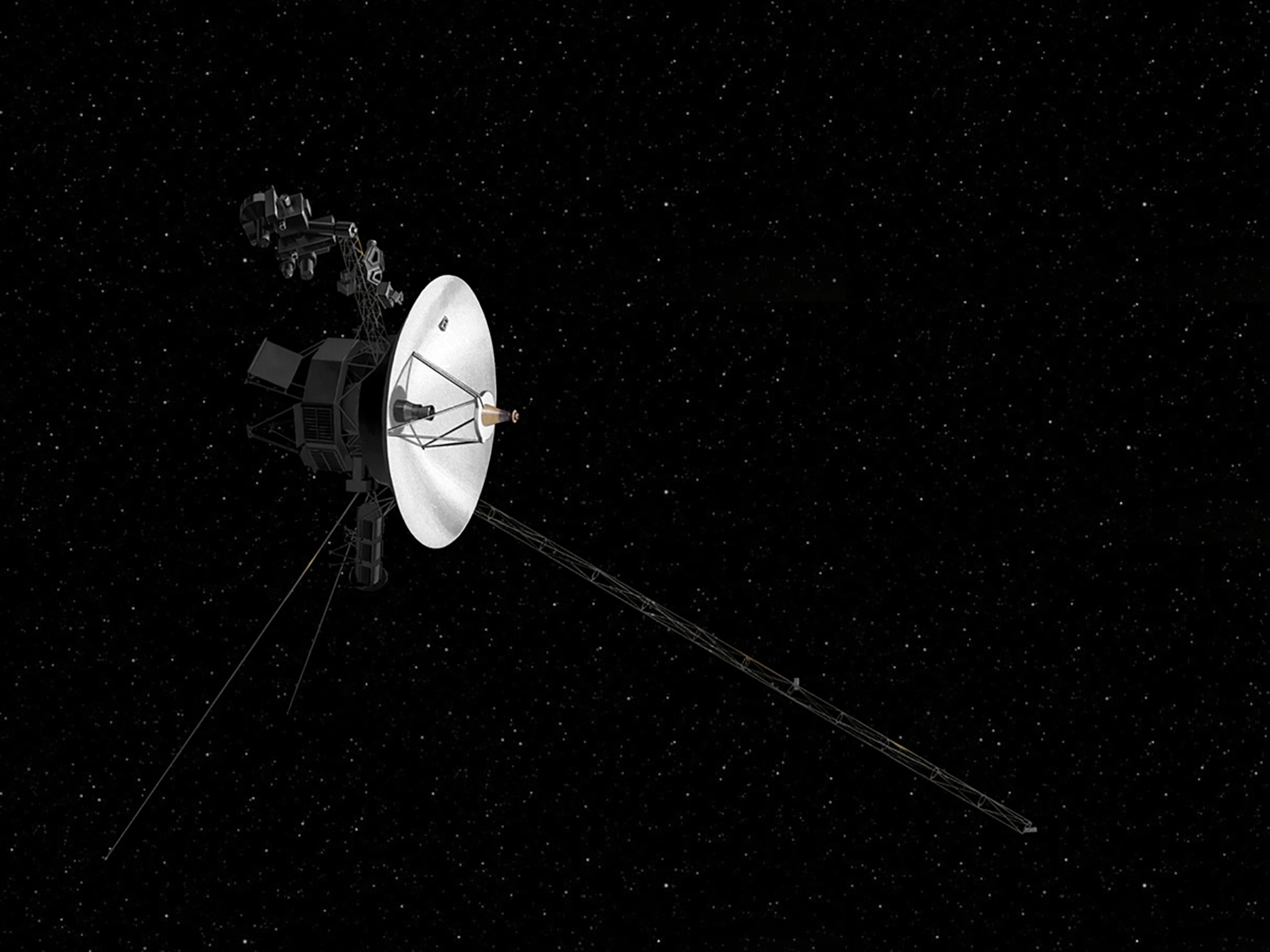
An illustration of one of the Voyager probes traveling in space.
“In those days, all the people I dealt with were optimists, and they thought the ETs would be friendly,” Drake says. “Nobody thought, even for a few seconds, about whether this might be a dangerous thing to do.”
So what are the chances of the map actually reaching extraterrestrial shores aboard the Voyagers?
“Very small,” Drake says. “The thing is going something like 10 kilometers per second, at which speed it takes—for the typical separation of stars—about half a million years to go from one star to another. And of course, it’s not aimed at any star, it’s just going where it’s going.”
If an extraterrestrial civilization has sufficiently powerful radars, it might be able to detect the Voyager spacecraft from afar. But that’s still unlikely, Drake says, which means the Voyagers’ sights, sounds, and maps to planet Earth may forever sail silently through the cosmos.
The reality is that humans have been passively announcing our presence to the cosmos for nearly a century via radar, radio, and TV transmissions. And with the rise of private space enterprises, who knows what new message to the stars might end up making its way into space?
Denning urges everyone to act thoughtfully and consider the pros and cons of intentionally hailing aliens.
“We're all on this Earth together,” she says.
Related Topics
- EXTRATERRESTRIAL LIFE

The 11 most astonishing scientific discoveries of 2023

How did life on Earth begin? Here are 3 popular theories.

Saturn’s ‘Death Star’ moon was hiding a secret: an underground ocean

U.S. returns to the moon as NASA's Odysseus successfully touches down

What is causing these massive, mysterious explosions in space?
- Environment
- Paid Content
History & Culture
- History & Culture
- History Magazine
- Gory Details
- 2023 in Review
- Mind, Body, Wonder
- Terms of Use
- Privacy Policy
- Your US State Privacy Rights
- Children's Online Privacy Policy
- Interest-Based Ads
- About Nielsen Measurement
- Do Not Sell or Share My Personal Information
- Nat Geo Home
- Attend a Live Event
- Book a Trip
- Inspire Your Kids
- Shop Nat Geo
- Visit the D.C. Museum
- Learn About Our Impact
- Support Our Mission
- Advertise With Us
- Customer Service
- Renew Subscription
- Manage Your Subscription
- Work at Nat Geo
- Sign Up for Our Newsletters
- Contribute to Protect the Planet
Copyright © 1996-2015 National Geographic Society Copyright © 2015-2024 National Geographic Partners, LLC. All rights reserved

Suggested Searches
- Climate Change
- Expedition 64
- Mars perseverance
- SpaceX Crew-2
- International Space Station
- View All Topics A-Z
Humans in Space
Earth & climate, the solar system, the universe, aeronautics, learning resources, news & events.

NASA’s PACE Data on Ocean, Atmosphere, Climate Now Available

Altitude Chamber Gets Upgrade for Artemis II, Spacecraft Testing Begins

NASA Next-Generation Solar Sail Boom Technology Ready for Launch
- Search All NASA Missions
- A to Z List of Missions
- Upcoming Launches and Landings
- Spaceships and Rockets
- Communicating with Missions
- James Webb Space Telescope
- Hubble Space Telescope
- Why Go to Space
- Astronauts Home
- Commercial Space
- Destinations
- Living in Space
- Explore Earth Science
- Earth, Our Planet
- Earth Science in Action
- Earth Multimedia
- Earth Science Researchers
- Pluto & Dwarf Planets
- Asteroids, Comets & Meteors
- The Kuiper Belt
- The Oort Cloud
- Skywatching
- The Search for Life in the Universe
- Black Holes
- The Big Bang
- Dark Energy & Dark Matter
- Earth Science
- Planetary Science
- Astrophysics & Space Science
- The Sun & Heliophysics
- Biological & Physical Sciences
- Lunar Science
- Citizen Science
- Astromaterials
- Aeronautics Research
- Human Space Travel Research
- Science in the Air
- NASA Aircraft
- Flight Innovation
- Supersonic Flight
- Air Traffic Solutions
- Green Aviation Tech
- Drones & You
- Technology Transfer & Spinoffs
- Space Travel Technology
- Technology Living in Space
- Manufacturing and Materials
- Science Instruments
- For Kids and Students
- For Educators
- For Colleges and Universities
- For Professionals
- Science for Everyone
- Requests for Exhibits, Artifacts, or Speakers
- STEM Engagement at NASA
- NASA's Impacts
- Centers and Facilities
- Directorates
- Organizations
- People of NASA
- Internships
- Our History
- Doing Business with NASA
- Get Involved
- Aeronáutica
- Ciencias Terrestres
- Sistema Solar
- All NASA News
- Video Series on NASA+
- Newsletters
- Social Media
- Media Resources
- Upcoming Launches & Landings
- Virtual Events
- Sounds and Ringtones
- Interactives
- STEM Multimedia

NASA’s Boeing Crew Flight Test Mission Overview

Hubble Spots a Galaxy Hidden in a Dark Cloud


NASA Shares Medical Expertise with New Space Station Partners

From NASA’s First Astronaut Class to Artemis II: The Importance of Military Jet Pilot Experience

Earth Day Poster 2024

NASA’s Lola Fatoyinbo Receives Royal Geographical Society Prize
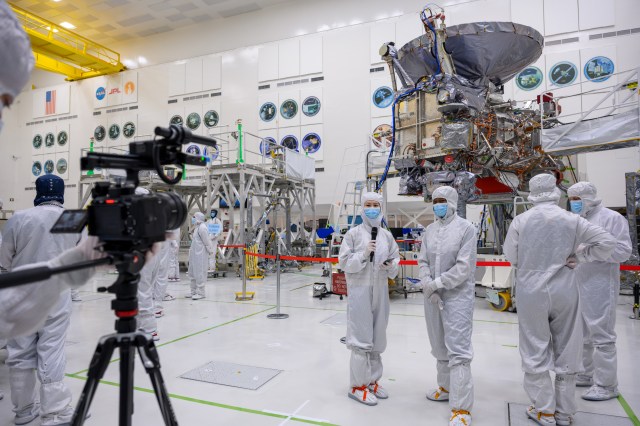
Media Get Close-Up of NASA’s Jupiter-Bound Europa Clipper

More Than 36,000 Volunteers Helped Do NASA Eclipse Science

NASA Names Finalists of the Power to Explore Challenge

NASA’s TESS Temporarily Pauses Science Observations
Earth Day 2024: Posters and Virtual Backgrounds

NASA Langley Team to Study Weather During Eclipse Using Uncrewed Vehicles

NASA Noise Prediction Tool Supports Users in Air Taxi Industry

ARMD Solicitations

Tech Today: Folding NASA Experience into an Origami Toolkit

NASA’s SERT II: ‘A Genuine Space Success Story’

NASA Partnerships Bring 2024 Total Solar Eclipse to Everyone

Shawnta M. Ball Turns Obstacles into Opportunities in Goddard’s Education Office

A Langley Intern Traveled 1,340 Miles to View a Total Solar Eclipse. Here’s What She Saw.

La presentación del X-59 de la NASA personifica la tradición aeronáutica
45 years ago: voyager 1 begins its epic journey to the outer planets and beyond, johnson space center.
Forty-five years ago, the Voyager 1 spacecraft began an epic journey that continues to this day. The second of a pair of spacecraft, Voyager 1 lifted off on Sept. 5, 1977, 16 days after its twin left on a similar voyage. NASA’s Jet Propulsion Laboratory (JPL) in Pasadena, California, managed the two spacecraft on their missions to explore the outer planets. Taking advantage of a rare planetary alignment to use the gravity of one planet to redirect the spacecraft to the next, the Voyagers planned to use Jupiter’s gravity to send them on to explore Saturn and its large moon Titan. They carried sophisticated instruments to conduct their in-depth explorations of the giant planets. Both spacecraft continue to return data as they make their way out of our solar system and enter interstellar space.
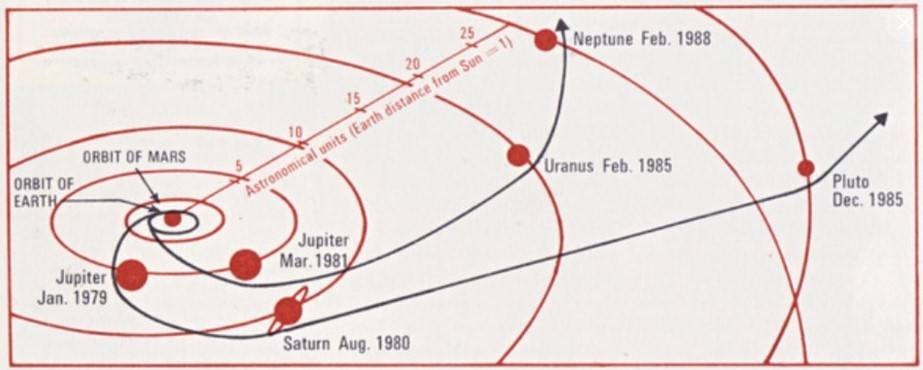
In the 1960s, mission designers at JPL noted that the next occurrence of a once-every-175-year alignment of the outer planets would happen in the late 1970s. A spacecraft could take advantage of this opportunity to fly by Jupiter and use its gravity to bend its trajectory to visit Saturn, and repeat the process to also visit Uranus, Neptune, and Pluto. Launching several missions to visit each planet individually would take much longer and cost much more. The original plan to send two pairs of Thermoelectric Outer Planet Spacecraft on these Grand Tours proved too costly leading to its cancellation in 1971. The next year, NASA approved a scaled-down version of the project to send a pair of Mariner-class spacecraft in 1977 to explore just Jupiter and Saturn, with an expected five-year operational life. On March 7, 1977, NASA Administrator James C. Fletcher announced the renaming of these Mariner Jupiter/Saturn 1977 spacecraft as Voyager 1 and 2. Scientists held out hope that one of them could ultimately visit Uranus and Neptune, thereby fulfilling most of the original Grand Tour’s objectives – Pluto would have to wait several decades for its first visit.
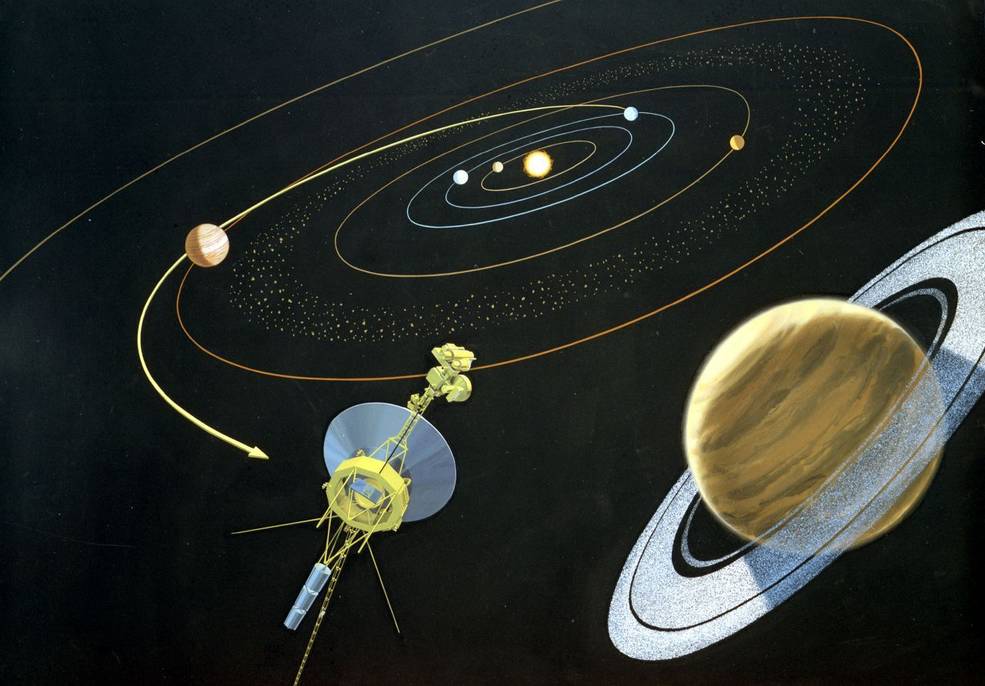
Each Voyager carried a suite of 11 instruments to study the planets during each encounter and to learn more about interplanetary space in the outer reaches of the solar system, including:
- An imaging science system consisting of narrow-angle and wide-angle cameras to photograph the planet and its satellites.
- A radio science system to determine the planet’s physical properties.
- An infrared interferometer spectrometer to investigate local and global energy balance and atmospheric composition.
- An ultraviolet spectrometer to measure atmospheric properties.
- A magnetometer to analyze the planet’s magnetic field and interaction with the solar wind.
- A plasma spectrometer to investigate microscopic properties of plasma ions.
- A low-energy charged particle device to measure fluxes and distributions of ions.
- A cosmic ray detection system to determine the origin and behavior of cosmic radiation.
- A planetary radio astronomy investigation to study radio emissions from Jupiter.
- A photopolarimeter to measure the planet’s surface composition.
- A plasma wave system to study the planet’s magnetosphere.
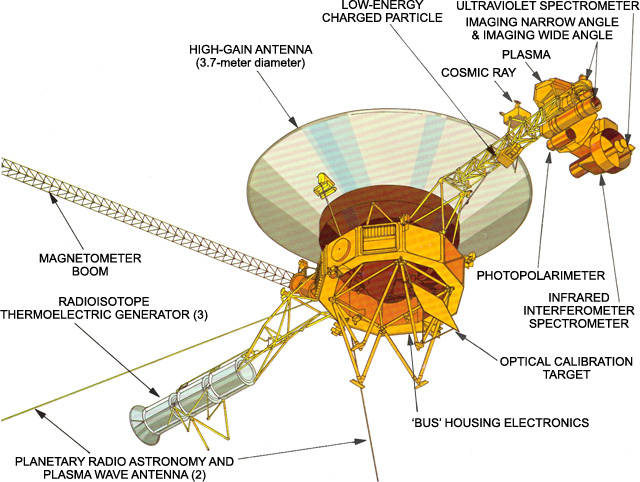
Voyager 1 lifted off on Sept. 5, 1977, atop a Titan IIIE-Centaur rocket from Launch Complex 41 at Cape Canaveral Air Force Station, now Cape Canaveral Space Force Station, in Florida. Two weeks after its launch, from a distance of 7.25 million miles, Voyager 1 turned its camera back toward its home planet and took the first single-frame image of the Earth-Moon system. The spacecraft successfully crossed the asteroid belt between Dec. 10, 1977, and Sept. 8, 1978.
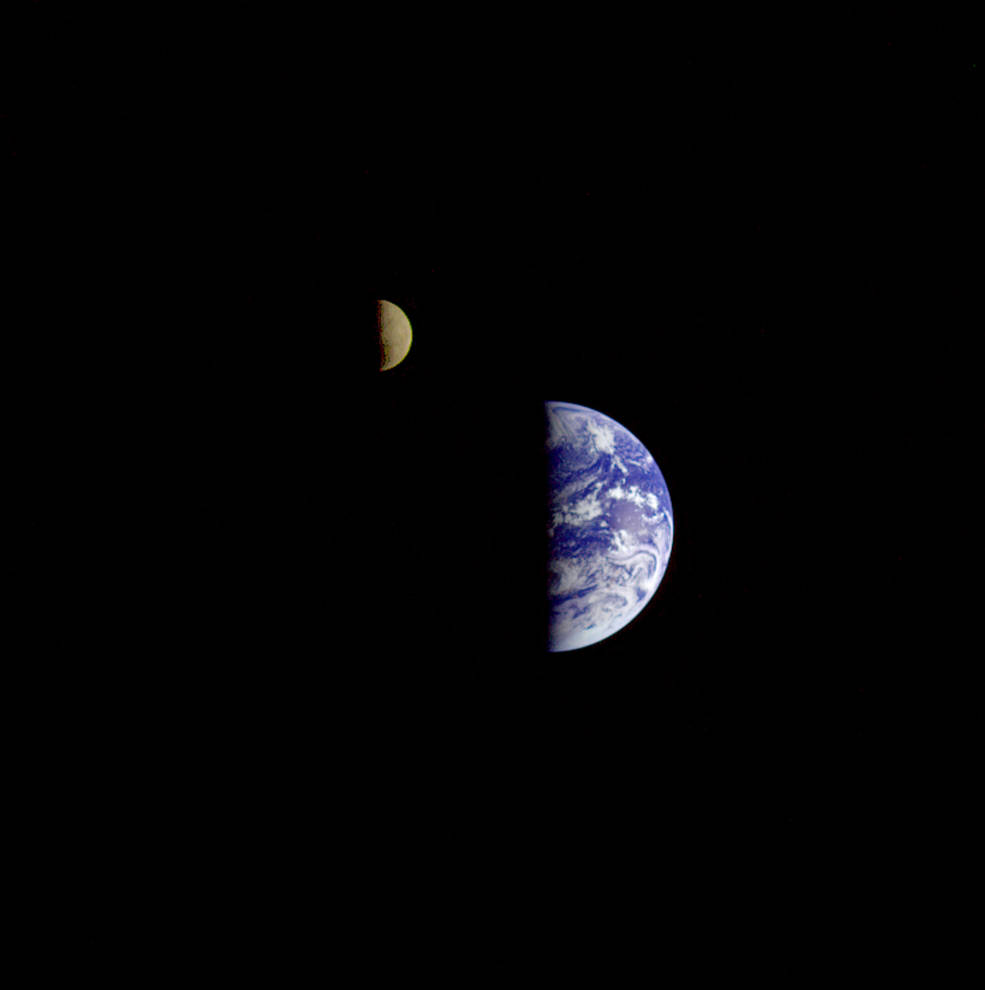
Although Voyager 1 launched two weeks after its twin, it traveled on a faster trajectory and arrived at Jupiter four months earlier. Voyager 1 conducted its observations of Jupiter between Jan. 6 and April 13, 1979, making its closest approach of 216,837 miles from the planet’s center on March 5. The spacecraft returned 19,000 images of the giant planet, many of Jupiter’s satellites, and confirmed the presence of a thin ring encircling it. Its other instruments returned information about Jupiter’s atmosphere and magnetic field. Jupiter’s massive gravity field bent the spacecraft’s trajectory and accelerated it toward Saturn.
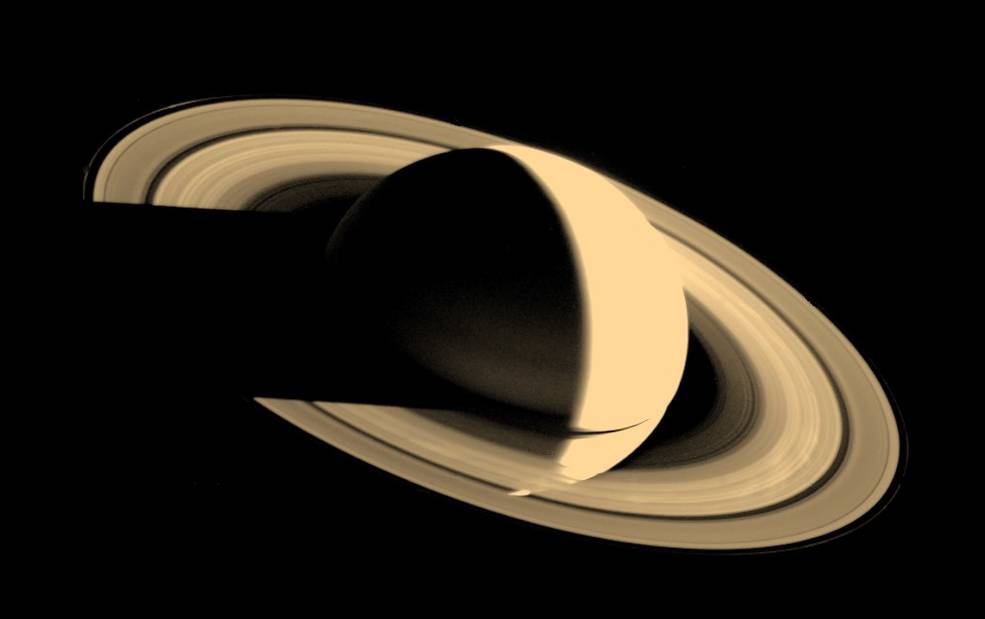
Voyager 1 began its long-range observations of Saturn on Aug. 22, 1980, passed within 114,500 miles of the planet’s center on Nov. 12, and concluded its studies on Dec. 14. Because of its interest to scientists, mission planners chose the spacecraft’s trajectory to make a close flyby of Saturn’s largest moon Titan – the only planetary satellite with a dense atmosphere – just before the closest approach to the planet itself. This trajectory, passing over Saturn’s south pole and bending north over the plane of the ecliptic, precluded Voyager 1 from making any additional planetary encounters. The spacecraft flew 4,033 miles from Titan’s center, returning images of its unbroken orange atmosphere and high-altitude blue haze layer. During the encounter, Voyager 1 returned 16,000 photographs, imaging Saturn, its rings, many of its known satellites and discovering several new ones, while its instruments returned data about Saturn’s atmosphere and magnetic field.

On Feb. 14, 1990, more than 12 years after it began its journey from Earth and shortly before controllers permanently turned off its cameras to conserve power, Voyager 1 spun around and pointed them back into the solar system. In a mosaic of 60 images, it captured a “family portrait” of six of the solar system’s planets, including a pale blue dot called Earth more than 3.7 billion miles away. Fittingly, these were the last pictures returned from either Voyager spacecraft. On Feb. 17, 1998, Voyager 1 became the most distant human-made object, overtaking the Pioneer 10 spacecraft on their way out of the solar system. In February 2020, to commemorate the photograph’s 30th anniversary, NASA released a remastered version of the image of Earth as Pale Blue Dot Revisited .
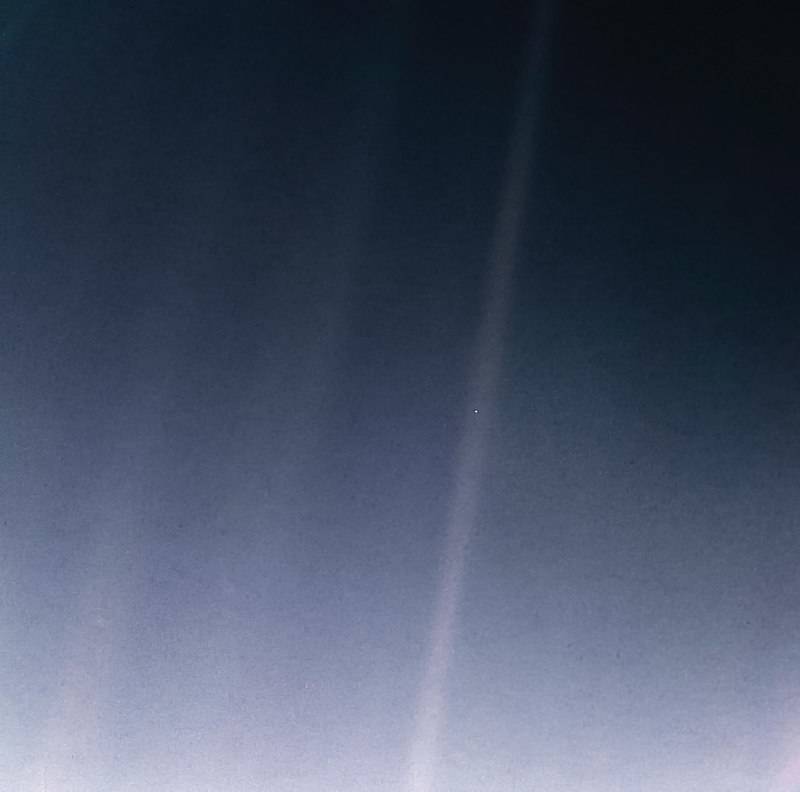
On New Year’s Day 1990, both spacecraft officially began the Voyager Interstellar Mission as they inexorably made their escape from our solar system. On Aug. 25, 2012, Voyager 1 passed beyond the heliopause, the boundary between the heliosphere, the bubble-like region of space created by the Sun, and the interstellar medium. Its twin followed suit six years later. Today , 45 years after its launch and 14.6 billion miles from Earth, four of Voyager 1’s 11 instruments continue to return useful data, having now spent 10 years in interstellar space. Signals from the spacecraft take nearly 22 hours to reach Earth, and 22 hours for Earth-based signals to reach the spacecraft. Engineers expect that the spacecraft will continue to return data from interstellar space until about 2025 when it will no longer be able to power its systems. And just in case an alien intelligence finds it one day, Voyager 1 like its twin carries a gold-plated record that contains information about its home planet, including recordings of terrestrial sounds, music, and greetings in 55 languages. Engineers at NASA thoughtfully included Instructions on how to play the record.
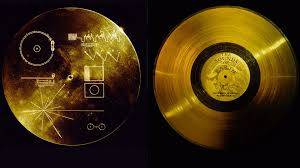
The voyage continues…

Voyager 1 and 2
The identical Voyager spacecraft are three-axis stabilized systems that use celestial or gyro referenced attitude control to maintain pointing of the high-gain antennas toward Earth. The prime mission science payload consisted of 10 instruments (11 investigations including radio science).
The command computer subsystem (CCS) provides sequencing and control functions The CCS contains fixed routines such as command decoding and fault detection and corrective routines, antenna pointing information, and spacecraft sequencing information.
The Attitude and Articulation Control Subsystem (AACS) controls spacecraft orientation, maintains the pointing of the high gain antenna towards Earth, controls attitude maneuvers, and positions the scan platform.
Uplink communications is via S-band (16-bits/sec command rate) while an X-band transmitter provides downlink telemetry at 160 bits/sec normally and 1.4 kbps for playback of high-rate plasma wave data. All data are transmitted from and received at the spacecraft via the 3.7 meter high-gain antenna (HGA).
Electrical power is supplied by three Radioisotope Thermoelectric Generators (RTGs). The current power levels are about 249 watts for each spacecraft. As the electrical power decreases, power loads on the spacecraft must be turned off in order to avoid having demand exceed supply. As loads are turned off, some spacecraft capabilities are eliminated.
Instruments
The prime mission science payload consisted of 10 instruments (11 investigations including radio science).
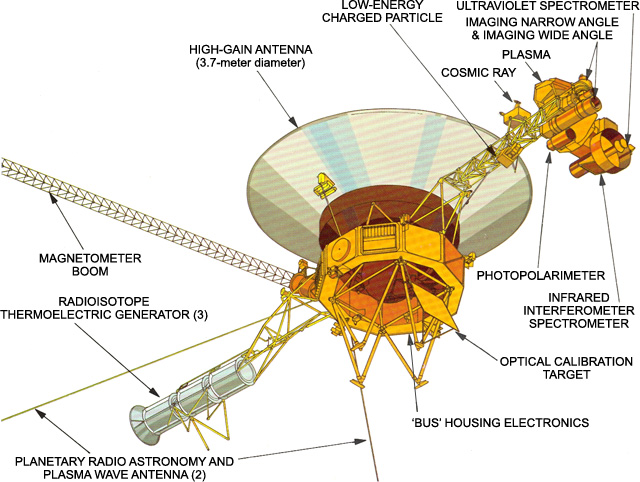
- Mobile Site
- Staff Directory
- Advertise with Ars
Filter by topic
- Biz & IT
- Gaming & Culture
Front page layout
Hope returns —
Nasa knows what knocked voyager 1 offline, but it will take a while to fix, "engineers are optimistic they can find a way for the fds to operate normally.".
Stephen Clark - Apr 6, 2024 12:28 am UTC
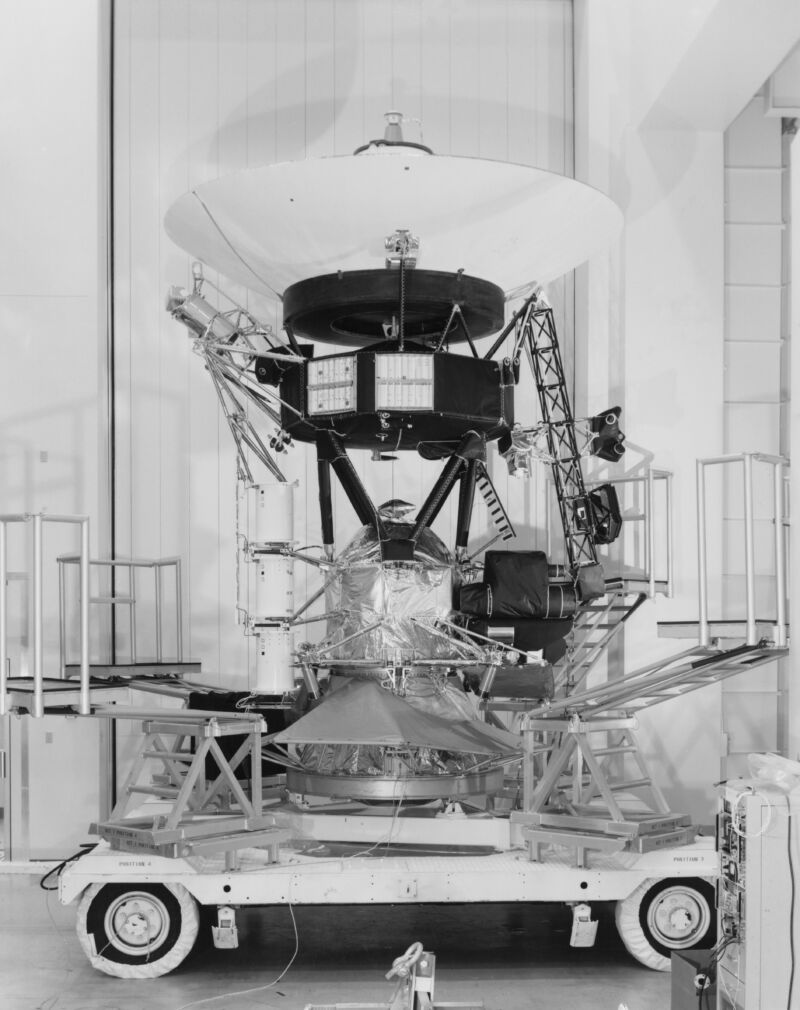
Engineers have determined why NASA's Voyager 1 probe has been transmitting gibberish for nearly five months, raising hopes of recovering humanity's most distant spacecraft.
Voyager 1, traveling outbound some 15 billion miles (24 billion km) from Earth, started beaming unreadable data down to ground controllers on November 14. For nearly four months, NASA knew Voyager 1 was still alive—it continued to broadcast a steady signal—but could not decipher anything it was saying.
Confirming their hypothesis, engineers at NASA's Jet Propulsion Laboratory (JPL) in California confirmed a small portion of corrupted memory caused the problem. The faulty memory bank is located in Voyager 1's Flight Data System (FDS), one of three computers on the spacecraft. The FDS operates alongside a command-and-control central computer and another device overseeing attitude control and pointing.
The FDS duties include packaging Voyager 1's science and engineering data for relay to Earth through the craft's Telemetry Modulation Unit and radio transmitter. According to NASA, about 3 percent of the FDS memory has been corrupted, preventing the computer from carrying out normal operations.
Optimism growing
Suzanne Dodd, NASA's project manager for the twin Voyager probes, told Ars in February that this was one of the most serious problems the mission has ever faced. That is saying something because Voyager 1 and 2 are NASA's longest-lived spacecraft. They launched 16 days apart in 1977, and after flying by Jupiter and Saturn, Voyager 1 is flying farther from Earth than any spacecraft in history. Voyager 2 is trailing Voyager 1 by about 2.5 billion miles, although the probes are heading out of the Solar System in different directions.
Normally, engineers would try to diagnose a spacecraft malfunction by analyzing data it sent back to Earth. They couldn't do that in this case because Voyager 1 has been transmitting data packages manifesting a repeating pattern of ones and zeros. Still, Voyager 1's ground team identified the FDS as the likely source of the problem.
The Flight Data Subsystem was an innovation in computing when it was developed five decades ago. It was the first computer on a spacecraft to use volatile memory. Most of NASA's missions operate with redundancy, so each Voyager spacecraft launched with two FDS computers. But the backup FDS on Voyager 1 failed in 1982.
Due to the Voyagers' age, engineers had to reference paper documents, memos, and blueprints to help understand the spacecraft's design details. After months of brainstorming and planning, teams at JPL uplinked a command in early March to prompt the spacecraft to send back a readout of the FDS memory.
The command worked, and Voyager1 responded with a signal different from the code it had been transmitting since November. After several weeks of meticulous examination of the new code, engineers pinpointed the location of the bad memory.
"The team suspects that a single chip responsible for storing part of the affected portion of the FDS memory isn’t working," NASA said in an update posted Thursday. "Engineers can’t determine with certainty what caused the issue. Two possibilities are that the chip could have been hit by an energetic particle from space or that it simply may have worn out after 46 years."
Voyager 1's distance from Earth complicates the troubleshooting effort. The one-way travel time for a radio signal to reach Voyager 1 from Earth is about 22.5 hours, meaning it takes roughly 45 hours for engineers on the ground to learn how the spacecraft responded to their commands.
NASA also must use its largest communications antennas to contact Voyager 1. These 230-foot-diameter (70-meter) antennas are in high demand by many other NASA spacecraft , so the Voyager team has to compete with other missions to secure time for troubleshooting. This means it will take time to get Voyager 1 back to normal operations.
"Although it may take weeks or months, engineers are optimistic they can find a way for the FDS to operate normally without the unusable memory hardware, which would enable Voyager 1 to begin returning science and engineering data again," NASA said.
reader comments
Channel ars technica.
Voyager Will Carry Earth Sounds Record

On the chance that someone is out there, NASA has approved tie placement of a phonograph record on each of two planetary spacecraft being readied far launch next month to the outer reaches of the solar system
The recording, called "Sounds of Earth" was placed Friday (July 29) aboard the first of two Voyager spacecraft scheduled to be launched to Jupiter, Saturn and beyond.
The 12-inch. copper disc contains greetings from Earth people in 60 languages, samples of music from different cultures and eras, and natural sounds of surf, wind and thunder, and birds, whales and other animals
The record also contains electronic information that an advanced technological civilization could convert into diagrams, pictures and printed words, including a message from President Carter.
The main Voyager objective is to conduct a detailed scientific investigation of giant Jupiter and ringed Saturn, 11 of their moons and possibly Uranus, before leaving the solar system to journey nearly endlessly among the stars.
The messages on the record were designed enable Possible extraterrestrial civilizations who might intercept the spacecraft millions of years, hence to put together some pictures of 20th century Earth and its inhabitants.
"Because space is very empty there is essentially no chance that Voyager will enter the planetary system of another star," said astronomer Carl Sagan of Cornell University. "The spacecraft will be encountered and the record played only if there are advanced spacefaring civilizations in interstellar space."
"But, as the beautiful messages from President Carter and Secretary General Waldheim indicate," he added, "the launching of this bottle into the cosmic ocean says something very hopeful about life on this planet."
The idea for the record was formulated by Sagan and the repertoire was selected by an advisory committee of prominent scientists, musicians and others. Sagan also was responsible for the plaques with a message previously sent into interstellar space aboard the Pioneer 10 and 11 spacecraft.
A phonograph record was chosen. because can carry much more information in the same space then for example the Pioneer plaques. In addition, 1977 is the 100th anniversary of the invention of the phonograph record by Thomas Alva Edison.
Each record is mace of copper and is in an aluminum protective jacket. It contains, in scientific language, information on how the record is to be played, using the cartridge and needle provided. The record begins with photographs and diagrams in analog form, depicting mathematics, chemistry, geology, and biology of the Earth, photographs of human beings of many countries, and some hint of the richness of our civilization. Included are schematics about the solar system, its dimensions and location in the Milky Way Galaxy, descriptions of DNA and human chromosomes, photographs of Earth, the Voyager launch vehicle, a large radio telescope and human beings in various settings and endeavors.
This is followed by spoken greetings in approximately 60 human languages, including a spoken message by Kurt Waldheim, Secretary General of the United Nations.
The Voyager record next includes a sound essay on the evolution of the planet Earth including sounds of weather and surf, the Earth before life, life before Man, and finally the development of human civilization.
The musical selections, which almost 90 minutes playing ~ ~e, a_~ representative of the c~ cultural d~ diversity of Earth, of many times and ,laces, and include both Eastern and Western classical music and a variety of ethnic music. Included is music from Senegal, Australia, Peru, Bulgaria, and Azerbaijan, as well as jazz and rock and roll. In the classical repertoire are compositions by Bach, Beethoven, Mozart, and Stravinsky , as well as Javanese Gamelan, Indian Raga, Japanese Skakuhachi, and Chinese Ch'in music. The entire 16 2/3 rpm record runs nearly two hours.
Because of the aluminum cover and the emptiness of interstellar space the record is likely to survive more than a billion years. Thus it represents not only a message into space but also a message into time, a point referred to in President Carter's message.
Among the members of Dr. Sagan's committee and others who played a major role in devising the Voyager record are Dr. Frank Drake, Cornell University; Dr. A. G. Cameron, Harvard University; Dr. Phillip Morrison, Massachusetts Institute of Technology; Dr. Bernard Olive, Hewlett-Packard Corporation; Dr. Leslie Orgel, Salk Institute; Dr. Alan Lomax, Choreometrics Project, Columbia University; Dr. Robert Brown, Center for World Music, Berkeley, California; Murry Sidlin, National Symphony Orchestra, Washington, D.C. and artist Jon Lomberg , Toronto, Canada. The record was produced Timothy Ferris; the creative director was Ann Druyan, both of New York City.
The record was prepared for NASA as a public service by Columbia Records. Permission to use copyrighted material on the record has been given to NASA by the owners, also as a public service.
The first Voyager will be launched aboard a Titan Centaur rocket on August 20, and the second or September 1. They will arrive at Jupiter in 1979, Saturn and its rings in 1980, and possibly examine Uranus in 1986. The two spacecraft will be considered to have left the solar system when they cross the orbit of Pluto in 1989
The Voyager spacecraft will escape the solar system at a speed of 17.2 km/sec (38,700 miles per hour), but this is a slow speed for interstellar distances. It will take at least 40,000 years before either spacecraft approaches another star - passing it at a distance of about one light year (six trillion miles). Other predictable approaches to stars will occur 147,000 and 525,000 years.
We finally know why NASA's Voyager 1 spacecraft stopped communicating — scientists are working on a fix
The first spacecraft to explore beyond the solar system started spouting gibberish late last year. Now, NASA knows why.

NASA engineers have discovered the cause of a communications breakdown between Earth and the interstellar explorer Voyager 1. It would appear that a small portion of corrupted memory exists in one of the spacecraft's computers.
The glitch caused Voyager 1 to send unreadable data back to Earth, and is found in the NASA spacecraft's flight data subsystem (FDS). That's the system responsible for packaging the probe's science and engineering data before the telemetry modulation unit (TMU) and radio transmitter send it back to mission control.
The source of the issue began to reveal itself when Voyager 1 operators sent the spacecraft a "poke" on March 3, 2024. This was intended to prompt FDS to send a full memory readout back to Earth.
The readout confirmed to the NASA team that about 3% of the FDS memory had been corrupted, and that this was preventing the computer from carrying out its normal operations.
Related: NASA finds clue while solving Voyager 1's communication breakdown case
Launched in 1977, Voyager 1 became the first human-made object to leave the solar system and enter interstellar space in 2012. Voyager 2 followed its spacecraft sibling out of the solar system in 2018, and is still operational and communicating well with Earth.
After 11 years of interstellar exploration, in Nov. 2023, Voyager 1's binary code — the computer language it uses to communicate with Earth — stopped making sense. Its 0's and 1's didn't mean anything anymore.
Get the Space.com Newsletter
Breaking space news, the latest updates on rocket launches, skywatching events and more!
"Effectively, the call between the spacecraft and the Earth was still connected, but Voyager's 'voice' was replaced with a monotonous dial tone," Voyager 1's engineering team previously told Space.com .

The team strongly suspects this glitch is the result of a single chip that's responsible for storing part of the affected portion of the FDS memory ceasing to work.
Currently, however, NASA can’t say for sure what exactly caused that particular issue. The chip could have been struck by a high-speed energetic particle from space or, after 46 years serving Voyager 1, it may simply have worn out.
— Voyager 2: An iconic spacecraft that's still exploring 45 years on
— NASA's interstellar Voyager probes get software updates beamed from 12 billion miles away
— NASA Voyager 2 spacecraft extends its interstellar science mission for 3 more years
Voyager 1 currently sits around 15 billion miles (24 billion kilometers) from Earth, which means it takes 22.5 hours to receive a radio signal from it — and another 22.5 hours for the spacecraft to receive a response via the Deep Space Network's antennas. Solving this communication issue is thus no mean feat.
Yet, NASA scientists and engineers are optimistic they can find a way to help FDS operate normally, even without the unusable memory hardware.
Solving this issue could take weeks or even months, according to NASA — but if it is resolved, Voyager 1 should be able to resume returning science data about what lies outside the solar system.
Join our Space Forums to keep talking space on the latest missions, night sky and more! And if you have a news tip, correction or comment, let us know at: [email protected].

Robert Lea is a science journalist in the U.K. whose articles have been published in Physics World, New Scientist, Astronomy Magazine, All About Space, Newsweek and ZME Science. He also writes about science communication for Elsevier and the European Journal of Physics. Rob holds a bachelor of science degree in physics and astronomy from the U.K.’s Open University. Follow him on Twitter @sciencef1rst.
SpaceX to launch a Falcon 9 rocket first stage for a record 20th time tonight
SpaceX launches advanced weather satellite for US Space Force (video)
HALO Space unveils capsule design for stratospheric space 'glamping'
- jcs Funny timing for this article, when I am streaming an old Star Trek movie. So, surely this didn't cause a 3 byte glitch removing the O, Y and A from Voyager's name buffer? Get it? Reply
- bwana4swahili It is quite amazing it has lasted this long in a space environment. Reply
bwana4swahili said: It is quite amazing it has lasted this long in a space environment.
- HankySpanky So now we know even better for next time. Perhaps a spare chipset that is not redundant but is ready to take over, stored in a protective environment. A task NASA can handle. We'll find out in 100 year or so - if humanity still exists. Reply
HankySpanky said: So now we know even better for next time. Perhaps a spare chipset that is not redundant but is ready to take over, stored in a protective environment. A task NASA can handle. We'll find out in 100 year or so - if humanity still exists.
- Classical Motion I'm afraid it might self repair. And download galactic knowledge, then decide we are a danger. And turn around. Reply
Classical Motion said: I'm afraid it might self repair. And download galactic knowledge, then decide we are a danger. And turn around.
- jcs ROFLOL! And a hot bald chick delivering the bad news! Reply
- View All 8 Comments
Most Popular
- 2 One of the universe's most 'extreme' dead stars just sprang back to life unexpectedly
- 3 'Space Shuttle Columbia: The Final Flight' documentary set to conclude on CNN
- 4 SpaceX to launch a Falcon 9 rocket first stage for a record 20th time tonight
- 5 No, you didn't see a solar flare during the total eclipse — but you may have seen something just as special
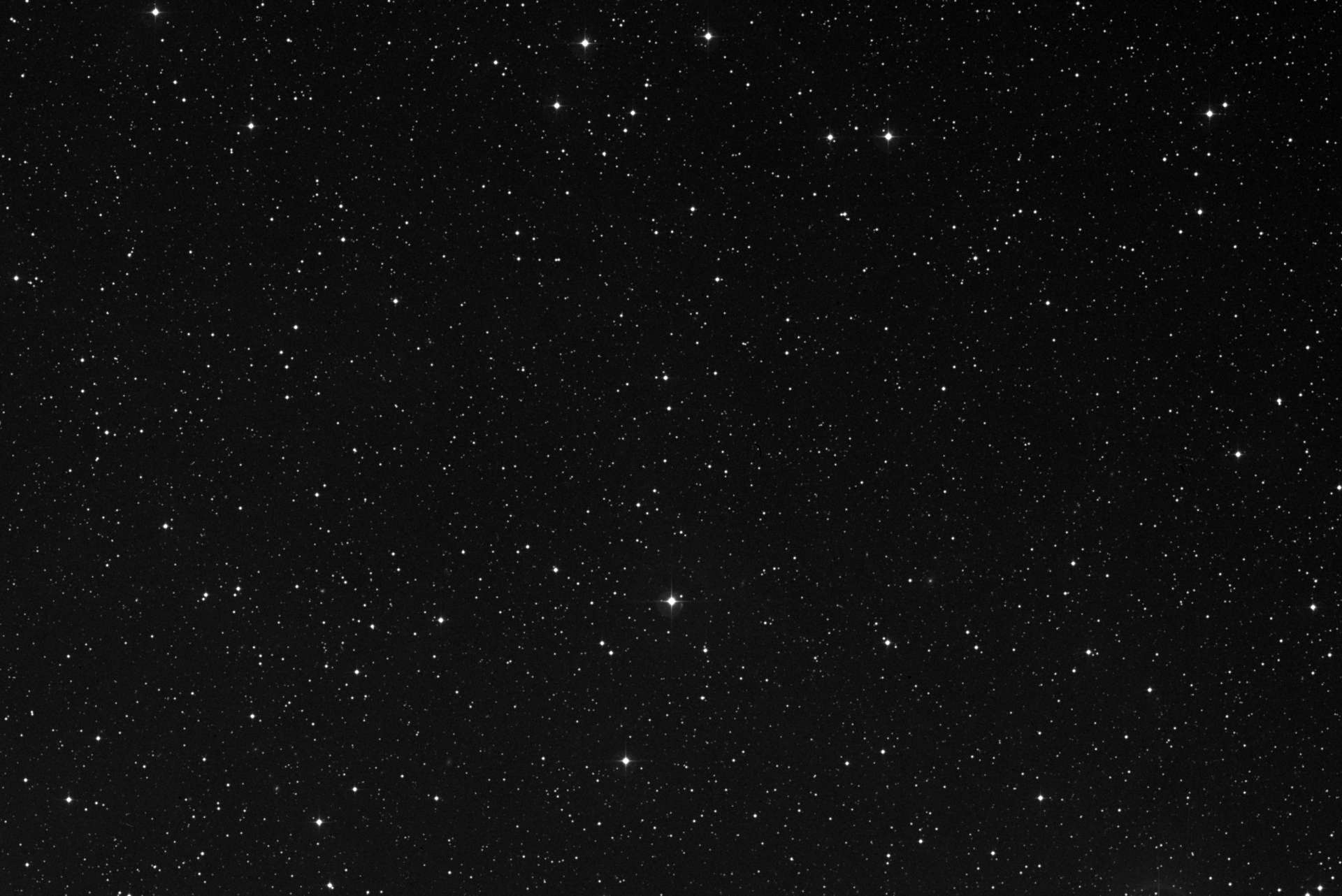
- Object Information
- Planetarium

Voyager 1 live position and data
This page shows Voyager 1 location and other relevant astronomical data in real time. The celestial coordinates, magnitude, distances and speed are updated in real time and are computed using high quality data sets provided by the JPL Horizons ephemeris service (see acknowledgements for details). The sky map shown in the background represents a rectangular portion of the sky 60x40 arcminutes wide. By comparison the diameter of the full Moon is about 30 arcmins, so the full horizontal extent of the map is approximately 2 full Moons wide. Depending on the device you are using, the map can be dragged horizondally or vertically using the mouse or touchscreen. The deep sky image in the background is provided by the Digitized Sky Survey ( acknowledgements ).
Current close conjunctions
List of bright objects (stars brighter than magnitude 9.0 and galaxies brighter than magmitude 14.0) close to Voyager 1 (less than 1.5 degrees):
Additional resources
- 15 Days Ephemerides
- Interactive Sky Map (Planetarium)
- Rise & Set Times
- Distance from Earth
Astronomy databases
- The Digitized Sky Survey, a photographic survey of the whole sky created using images from different telescopes, including the Oschin Schmidt Telescope on Palomar Mountain
- The Hipparcos Star Catalogue, containing more than 100.000 bright stars
- The PGC 2003 Catalogue, containing information about 1 million galaxies
- The GSC 2.3 Catalogue, containing information about more than 2 billion stars and galaxies
NASA engineers discover why Voyager 1 is sending a stream of gibberish from outside our solar system
Voyager 1 has been sending a stream of garbled nonsense since November. Now NASA engineers have identified the fault and found a potential workaround.
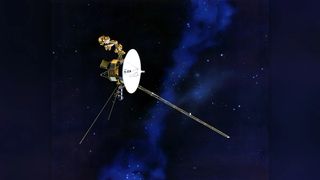
For the past five months, the Voyager 1 spacecraft has been sending a steady stream of unreadable gibberish back to Earth. Now, NASA engineers finally know why.
The 46-year-old spacecraft sends regular radio signals as it drifts further from our solar system . But in November 2023, the signals suddenly became garbled, meaning scientists were unable to read any of its data, and they were left mystified about the fault's origins.
In March, NASA engineers sent a command prompt, or "poke," to the craft to get a readout from its flight data subsystem (FDS) — which packages Voyager 1's science and engineering data before beaming it back to Earth.
After decoding the spacecraft's response, the engineers have found the source of the problem: The FDS's memory has been corrupted.
Related: NASA's Voyager 1 sends readable message to Earth after 4 nail-biting months of gibberish
"The team suspects that a single chip responsible for storing part of the affected portion of the FDS memory isn't working," NASA said in a blog post Wednesday (March 13) . "Engineers can't determine with certainty what caused the issue. Two possibilities are that the chip could have been hit by an energetic particle from space or that it simply may have worn out after 46 years."
— NASA hears 'heartbeat' signal from Voyager 2 probe a week after losing contact
— Historic space photo of the week: Voyager 2 spies a storm on Saturn 42 years ago
— NASA reestablishes full contact with Voyager 2 probe after nail-biting 2-week blackout
Although it may take several months, the engineers say they can find a workaround to run the FDS without the fried chip — restoring the spacecraft's messaging output and enabling it to continue to send readable information from outside our solar system.
Sign up for the Live Science daily newsletter now
Get the world’s most fascinating discoveries delivered straight to your inbox.
Launched in 1977, Voyager 1 zipped past Saturn and Jupiter in 1979 and 1980 before flying out into interstellar space in 2012. It is now recording the conditions outside of the sun's protective magnetic field , or heliosphere, which blankets our solar system.
Voyager 1 is currently more than 15 billion miles (24 billion kilometers) from Earth, and it takes 22.5 hours for any radio signal to travel from the craft to our planet.

Ben Turner is a U.K. based staff writer at Live Science. He covers physics and astronomy, among other topics like tech and climate change. He graduated from University College London with a degree in particle physics before training as a journalist. When he's not writing, Ben enjoys reading literature, playing the guitar and embarrassing himself with chess.
NASA spacecraft snaps mysterious 'surfboard' orbiting the moon. What is it?
The moon is getting its own time zone, White House memo to NASA reveals
Why I watched the solar eclipse with my kids, a goose and 2,000 trees
- TorbjornLarsson Bon voyage, Voyager! Reply
- Jay McHue What if aliens are doing it to try to communicate with us? 🤪 Reply
Jay McHue said: What if aliens are doing it to try to communicate with us? 🤪
admin said: Voyager 1 has been sending a stream of garbled nonsense since November. Now NASA engineers have identified the fault and found a potential workaround. NASA engineers discover why Voyager 1 is sending a stream of gibberish from outside our solar system : Read more
sourloaf said: What does FSB mean?
Rusty Lugnuts said: Where are you seeing "FSB"? The closest thing I can see in the article is "FDS". In modern computers, FSB would most likely refer to the Fr0nt S1ide Bu5, though I have no idea if a system as old as Voyagers, let alone engineered so specifically, would have an FSB. (apparently I can't spell out "Fr0nt S1ide Bu5" or my post gets flagged as spam or inappropriate??)
- SkidWard Just cut the % of ram needed... skip the bad sectors Reply
- kloudykat FDS = fl1ght da1a sub5ystem5 Reply
- 5ft24dave This is pretty old news, like 6 months old. Are you guys just now discovering this? Reply
Commodore Browncoat said: That's about as sane a theory as many of the others that have become ridiculously popular in the past several years, so sure - why not? What reply do you think we should send?
- View All 11 Comments
Most Popular
By Peter Ray Allison April 10, 2024
By Tom Metcalfe April 09, 2024
By Rebecca Sohn April 09, 2024
By Stephanie Pappas April 09, 2024
By Samantha Mathewson April 09, 2024
By Nicoletta Lanese April 09, 2024
By Sascha Pare April 09, 2024
By Emily Cooke April 09, 2024
By Harry Baker April 09, 2024
- 2 Here are the best photos of the April 8 total solar eclipse over North America
- 3 Part of the San Andreas fault may be gearing up for an earthquake
- 4 Pet fox with 'deep relationship with the hunter-gatherer society' buried 1,500 years ago in Argentina
- 5 NASA engineers discover why Voyager 1 is sending a stream of gibberish from outside our solar system
- 2 Pet fox with 'deep relationship with the hunter-gatherer society' buried 1,500 years ago in Argentina
- 3 No, you didn't see a solar flare during the total eclipse — but you may have seen something just as special
- 4 Neolithic women in Europe were tied up and buried alive in ritual sacrifices, study suggests
- 5 Superfast drone fitted with new 'rotating detonation rocket engine' approaches the speed of sound
Google Earth
Create stories and maps.
With creation tools, you can draw on the map, add your photos and videos, customize your view, and share and collaborate with others.
Create on Earth
Draw on the map.
Add placemarks to highlight key locations in your project, or draw lines and shapes directly on the map.
Add your photos and videos
Feature images and videos on your map to add rich contextual information.
Customize your view
Make use of Google Earth's detailed globe by tilting the map to save a perfect 3D view or diving into Street View for a 360 experience.
Share your story with the world
Collaborate with others like a Google Doc and share your story as a presentation.

Star Trek: Voyager's original ending had a surprise for the Borg
T he ending of Star Trek: Voyager didn't completely satisfy fans as we didn't get to see Voyager actually back on Earth nor did we see the crew reuniting with their friends and families. Instead, we see Voyager heading toward Earth, which wasn't exactly epic. But the original finale, according to Bryan Fuller [ via Giant Freakin Robot ], would have been a grand finale like no other with Captain Janeway taking on the Borg in an epic showdown.
According to Fuller, originally, because Kate Mulgrew wanted the captain to "go down with the ship but not at the full cost of her being," Captain Janeway was going to surrender Voyager to the Borg. But there was a nasty surprise waiting for the Collective—a reverse assimilation virus which would have destroyed the Borg from the inside out. The Voyager crew would have been able to use a transwarp conduit to make it back to Earth.
As Voyager escaped, an armada of Borg cubes would have followed, and the end result would have been quite the finale.
“This great final image of the Borg armada approaching Earth, and then out of the belly of the beast of the lead ship came Voyager, destroying all of the other Borg in its trail.”Bryan Fuller
Fuller thought this would have been the right way to end Janeway's journey with the Borg and would have given Seven of Nine complete freedom. Whether or not Janeway would have died in this version of the finale was still up in the air, but, like the hologram Janeway aboard the Protostar, it's a sacrifice she would have made either way.
Though this could have resulted in a finale that really resonated with fans, it could have essentially cost us Captain Janeway. With the powers-that-be unsure of whether or not she would have survived, this is a risk I'm glad they didn't take. The death of Janeway would have been traumatic, not only for her crew, but for those fans who would have gladly joined her crew. And since Voyager ended differently, Janeway has now returned as an admiral in the animated series, Star Trek: Prodigy. And most of us fans are holding out hope for a live-action return of the admiral. With so much Star Trek going on, there are plenty of places for her to pop up!
This article was originally published on redshirtsalwaysdie.com as Star Trek: Voyager's original ending had a surprise for the Borg .


- The Contents
- The Making of
- Where Are They Now
Frequently Asked Questions
- Q & A with Ed Stone
golden record
Where are they now.
- frequently asked questions
- Q&A with Ed Stone
Can the Voyager imaging cameras be turned back on?
What instruments on the spacecraft are still working and what have been turned off?
How long can Voyager 1 and 2 continue to function?
Voyager 1 is expected to keep its current suite of science instruments on through 2021. Voyager 2 is expected to keep its current suite of science instruments on through 2020.
The radioisotope thermoelectric generator on each spacecraft puts out 4 watts less each year. Because of this diminishing electrical power, the Voyager team has had to prioritize which instruments to keep on and which to turn off. Heaters and other spacecraft systems have also been turned off one by one as part of power management.
The Voyager team has chosen to keep operating the instruments that are the most likely to send back key data about the heliosphere and interstellar space -- the fields and particles instruments. Engineers expect to begin turning off fields and particles science instruments one by one, starting in 2020 for Voyager 2. Voyager 2 will have to start turning science instruments off sooner because it is currently operating one more instrument than Voyager 1. Engineers expect each spacecraft to continue operating at least one science instrument until around 2025.
Even if science data won't likely be collected after 2025, engineering data could continue to be returned for several more years. The two Voyager spacecraft could remain in the range of the Deep Space Network through about 2036, depending on how much power the spacecraft still have to transmit a signal back to Earth.
Where are Voyager 1 and 2 today? How do they compare to other spacecraft on an outbound trajectory?
Where is Voyager 1 going? When will it get there? How about Voyager 2?
Where do we consider our solar system to end; Pluto's orbit? Solar apex?
Have any human-made objects ever exited the solar system?
Are the distance counters rolling backwards?
Did either of the Voyagers visit Pluto? Why didn't the Voyagers fly by Pluto?
When we send spacecraft through the asteroid belt to the outer planets, how do we navigate the craft through the belt?
I was reading Dr. Carl Sagan's biography recently and found that he persuaded NASA administrators to turn one of the Voyager space probes around in order to take a last image of the solar system. Is this true? Do the craft send back any images of where they are?
I can not locate a copy of the Murmurs of Earth CD. Would you know of a vendor that might sell copies of it?
Who was on the committee with Dr. Sagan regarding the development of the Golden Record? Both American or foreign scientists?
If there is intelligent life in our universe and they were not a peace loving species, wouldn't the information on the Voyager be enough to destroy human kind?
What were the most important discoveries of the Voyager space probes?
How big is Voyager? How much does it weigh?
Is it true that a sketch by Da Vinci is included in the "Message to the Universe" of Voyagers 1 and 2?
What kind of computers are used on the Voyager spacecraft?
How fast are the Voyager computers?
What is the "direction" (constellation and/or star) both VOYAGER 1 & 2 and the Pioneers are "aimed" for, at present.
Where can I find pictures of what the Voyager spacecraft took?
Is there some sort of plate with pictograms on the Voyager 1 spacecraft? Also is it similar to the Pioneer spacecraft plaque?

IMAGES
VIDEO
COMMENTS
Distance from Earth This is a real-time indicator of Voyagers' distance from Earth in astronomical units (AU) and either miles (mi) or kilometers (km). Note: Because Earth moves around the sun faster than Voyager 1 is speeding away from the inner solar system, the distance between Earth and the spacecraft actually decreases at certain times of ...
This is a real-time indicator of Voyager 1's distance from Earth in astronomical units (AU) and either miles (mi) or kilometers (km). Note: Because Earth moves around the sun faster than Voyager 1 is speeding away from the inner solar system, the distance between Earth and the spacecraft actually decreases at certain times of year.
Mission Overview. The twin Voyager 1 and 2 spacecraft are exploring where nothing from Earth has flown before. Continuing on their more-than-40-year journey since their 1977 launches, they each are much farther away from Earth and the sun than Pluto. In August 2012, Voyager 1 made the historic entry into interstellar space, the region between ...
Voyager 1 is a space probe launched by NASA on September 5, 1977, to study the outer Solar System and beyond. It is currently the most distant human-made object from Earth, having traveled over 14 billion miles (23 billion kilometers) from the Sun. Voyager 1's mission has included flybys of Jupiter and Saturn, with the goal of studying their moons, rings, and magnetic fields.
As of 2021, Voyager 1 is about 155 astronomical units (14.4 billion miles) from Earth, and Voyager 2 is nearly 129 astronomical units (12 billion miles) away. ... a map of our solar system's location with respect to a set of 14 pulsars, and a drawing of a hydrogen atom. They are plated with uranium - its rate of decay will allow any future ...
Voyager 1 and its twin Voyager 2 are the only spacecraft ever to operate outside the heliosphere, the protective bubble of particles and magnetic fields generated by the Sun. Voyager 1 reached the interstellar boundary in 2012, while Voyager 2 (traveling slower and in a different direction than its twin) reached it in 2018. Mission Type.
Voyager 1 is now 7 billion kilometers (4.3 billion miles) from Earth, traveling at a heliocentric velocity of 63,800 km/hr (39,700 mph). Voyager 2, traveling in the opposite direction from its twin, is 5.3 billion kilometers (3.3 billion miles) from Earth with a heliocentric velocity of 59,200 km/hr (36,800 mph).
Voyager 2 is now more than 96 AU from the sun, traveling at a speed of 15.5 kilometers per second (9.6 miles per second). Both spacecraft are moving considerably faster than Pioneers 10 and 11, two earlier spacecraft that became the first robotic visitors to fly past Jupiter and Saturn in the mid-70s. This processed color image of Jupiter was ...
How a NASA Spacecraft May Help Aliens Find Earth. The pulsar maps on the Voyager probes pinpoint our location in the galaxy—even as some experts debate the pros and cons of signaling ET. Forty ...
We now have five spacecraft that have either reached the edges of our solar system or are fast approaching it: Pioneer 10, Pioneer 11, Voyager 1, Voyager 2 and New Horizons. Most of these probes ...
An online planetarium application that shows where to locate Voyager 2 in the sky from your location. ... Between 1 January 2013 and 30 December 2099, the closest approach of Voyager 2 to Earth happens on Sun Jun 2 2013 at a distance of 101.162452 Astronomical Units, or 15,133,687,450 kilometers: Date Sun Jun 2 2013. Distance ...
This chart shows the location of Voyager 2 as it leaves the solar system. ... On June 3, 2023, Voyager 2 and Earth will be 132.89427 AU apart. After that, we will begin to separate in distance ...
Left: Remastered Voyager 1 photograph of Earth, Pale Blue Dot Revisited, taken from 3.7 billion miles away, released in February 2020. Earth is the tiny point of light near the image's center. Right: An illustration showing the position of the Voyager 1 and 2 spacecraft outside of the heliosphere, a protective bubble
Voyager 2 is currently in the constellation of Pavo, more than 12.3 billion miles away from Earth, while Voyager 1 is in the constellation of Ophiucus 1 almost 15 billion miles from Earth.
The identical Voyager spacecraft are three-axis stabilized systems that use celestial or gyro referenced attitude control to maintain pointing of the high-gain antennas toward Earth. The prime mission science payload consisted of 10 instruments (11 investigations including radio science).
The one-way travel time for a radio signal to reach Voyager 1 from Earth is about 22.5 hours, meaning it takes roughly 45 hours for engineers on the ground to learn how the spacecraft responded to ...
Voyager Will Carry Earth Sounds Record. Aug. 1, 1977. This artist's concept shows NASA's Voyager spacecraft against a backdrop of stars. On the chance that someone is out there, NASA has approved tie placement of a phonograph record on each of two planetary spacecraft being readied far launch next month to the outer reaches of the solar system ...
Voyager 1 flew within 64,200 kilometers (40,000 miles) of the cloud tops, while Voyager 2 came within 41,000 kilometers (26,000 miles). Saturn is the second largest planet in the solar system. It takes 29.5 Earth years to complete one orbit of the Sun, and its day was clocked at 10 hours, 39 minutes.
Voyager 1 currently sits around 15 billion miles (24 billion kilometers) from Earth, which means it takes 22.5 hours to receive a radio signal from it — and another 22.5 hours for the spacecraft ...
Voyager 1 live position and data. This page shows Voyager 1 location and other relevant astronomical data in real time. The celestial coordinates, magnitude, distances and speed are updated in real time and are computed using high quality data sets provided by the JPL Horizons ephemeris service (see acknowledgements for details). The sky map shown in the background represents a rectangular ...
For months now, the most distant spacecraft to Earth - Voyager 1 - has been talking gibberish on the interplanetary 'radio'. The repetitive jumble of 1s and 0s it's sending back to our planet, 24 billion kilometers (15 billion miles) away, has made no sense to scientists until now.
An artist's illustration of Voyager 1 with its antenna pointed back at Earth. (Image credit: NASA/JPL) For the past five months, the Voyager 1 spacecraft has been sending a steady stream of ...
Make use of Google Earth's detailed globe by tilting the map to save a perfect 3D view or diving into Street View for a 360 experience. ... Choose your adventure with Voyager
The Voyager crew would have been able to use a transwarp conduit to make it back to Earth. As Voyager escaped, an armada of Borg cubes would have followed, and the end result would have been quite ...
Voyager imaged Earth's moon and discovered twenty-three new moons at the outer planets. Voyager made significant improvements in the measurements of the magnetospheres at Jupiter and Saturn and provided the first measurements of the magnetospheres at Uranus and Neptune. ... It shows the location of the solar system with respect to 14 pulsars ...
The glitch paused Voyager 1's science work and kicked off a long-distance diagnosis process. The team traced the issue to the flight data subsystem, a computer that talks to the spacecraft's ...
A total solar eclipse occurs when the moon passes between Earth and the sun, completely blocking the sun's face. Those within the path of totality, including 32 million people in the United States ...